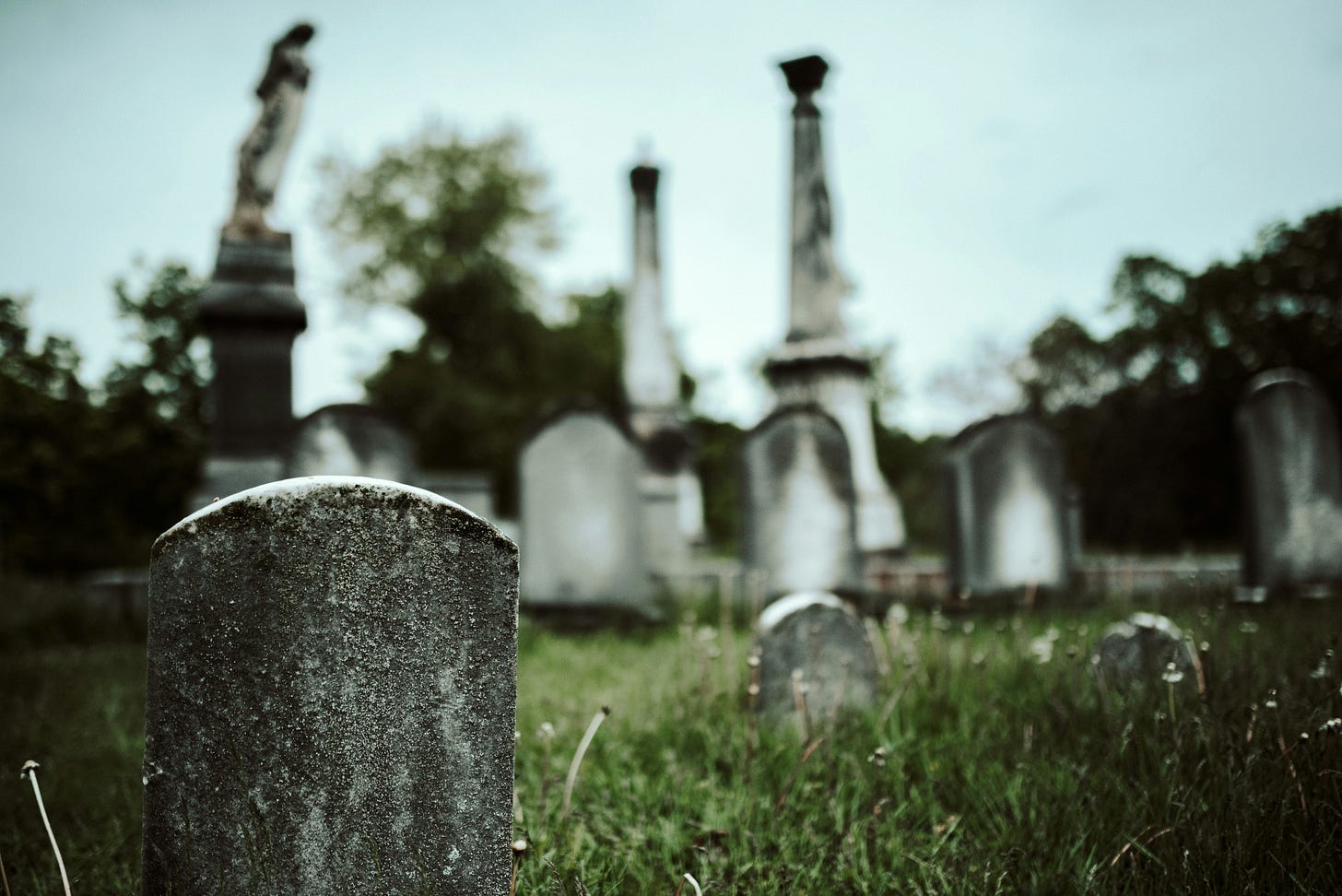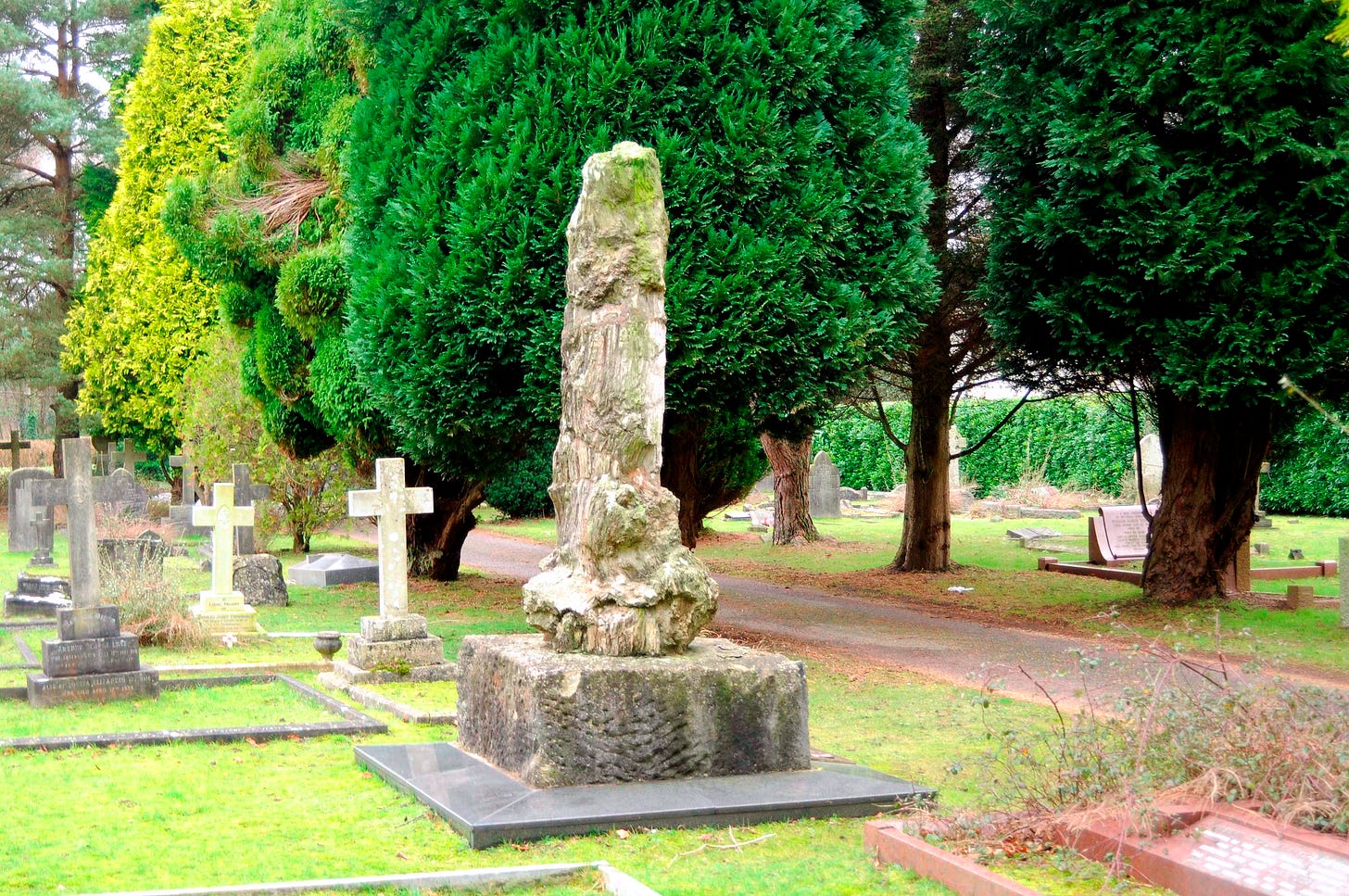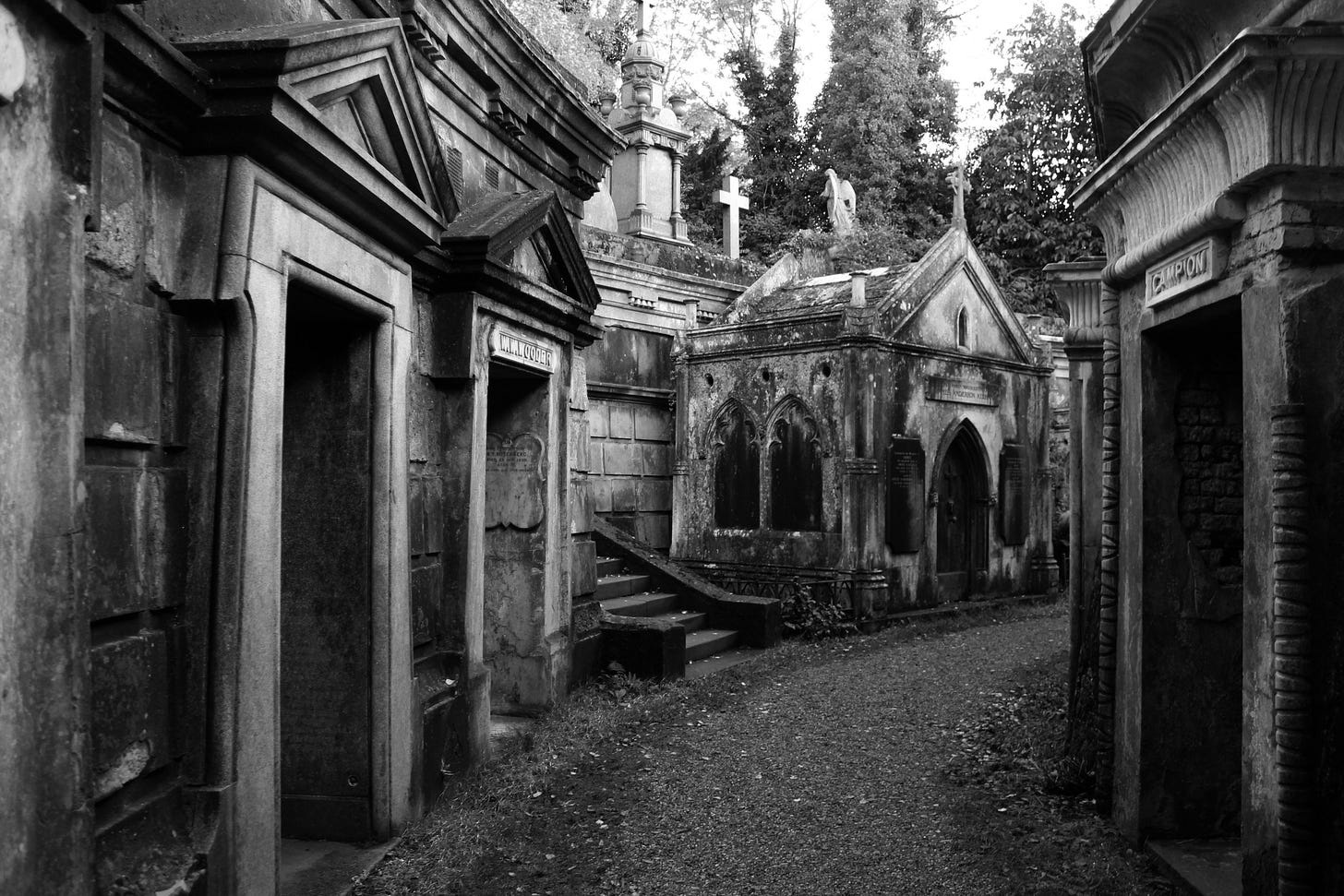A Modest Proposal for Life After Death
Human existence is an astonishing menagerie of vibrant forms. We should stop leaving such banal, meaningless traces of ourselves after we die.

Thank you for reading The Garden of Forking Paths. This edition is for everyone, but if you value my writing and research, please upgrade to a paid subscription to support my work—and to fully unlock the archive of 200+ essays. I rely exclusively on reader support. Alternatively, you can support my writing by buying my award-winning book, FLUKE.
I: Electrified and Petrified
Across southern England, July 1955 was one of the hottest and sunniest months on record. And when that strange golden-yellow orb—alien and unknown for much of the year—graces English skies, teenagers will, without fail, gallivant in that particularly wholesome, carefree way that only comes with the feeling of having one’s vast life story still waiting to be written.
As temperatures climbed on Thursday, July 14th, two eighteen year-olds named Douglas Lane and Anthony Willis rode their bicycles to the local swimming pool. After cooling down, they again pedaled off, whizzing through Southampton’s bustling streets, eager to meet their mutual friend, Betty Bolton.
The three were out of 1950s central casting for upright pastoral youth; the boys taught at their local church Sunday school, while Betty accompanied their lessons on the piano. She was preparing to become a schoolteacher. Anthony was soon to be off to Cambridge University. And Douglas, for his part, had recently qualified to train as a pilot in the Royal Air Force.
But as they met up, the blue skies clouded over, rapidly darkening. With thunderstorms rolling in, sheets of rain began to fall on the unprepared teenagers. They turned into Southampton Common, seeking shelter under the sprawling branches of a soaring oak tree. Then, without warning, a flash of light and a crack—a booming sound they would never hear. A single bolt of lightning. The voltage coursed through their bodies. They never woke again.1
A few months ago, while walking through Southampton’s Old Cemetery, I stumbled upon the only physical remnant of Douglas Lane left on planet Earth, a simple, non-descript gravestone with the following message:
TO THE MEMORY OF DOUGLAS R G LANE
AGED 18 YEARS
SON OF DOUGLAS & RITA KILLED BY LIGHTNING ON SOUTHAMPTON COMMON WITH TWO FRIENDS WHEN SHELTERING FROM A STORM JULY 14TH 1955
Because Douglas died instantly, I knew something about him that he had not—that he had been killed by lightning. It occurred to me that the only fact memorialized about his tragically short life was a moment that he never experienced. His gravestone was a particularly stark example of that principle, but the more I strolled through the cemetery, the more I boggled at how frequently it held true.
Row upon row of graves, whether etched into faded limestone or preserved in darker granite, captured little more of the individuals who lay beneath than their dates of birth and death. We are not consciously aware of either experience. While we all learn the date of our birth, few of us will ever know the date of our death.
And yet, when it comes to leaving our mark on the planet for future generations to remember us, too often we reduce the complex beauty and nuanced wrinkles of the infinite medley of human personalities into a mere record of two dates never experienced, chiseled into stones that are seemingly mass produced, designed to closely resemble all the others. Humanity’s menagerie of endless forms most beautiful is honored, alas, by deliberate uniformity.
I do not yet know how I would like to be remembered—if at all—by unknown strangers ambling through overgrown grasses in the future, but I can say this with confidence: the dates of my birth and death will be two of the least salient facts about my sense of self, identity, and the meaning of my existence.
Dates and numbers are for record keeping. The ancient Mesopotamians may have invented writing to keep inventories of sheep stocks and oil supplies, but the Epic of Gilgamesh left us a piece of their cultural soul. Likewise, graves should be for remembering who we are and how we lived our lives, not just marking the span of time within which we blinked into existence.
A year or two before I entered Southampton’s cemetery, I was standing in a graveyard thirty miles to the southwest, in a charming little Dorset village called Broadstone. I parked my car in a small gravel lot that was deserted (save for an old man walking his feisty spaniel) and gazed into a cookie-cutter replica of countless charming village graveyards dotted across Britain: a lovely parish church, carved crosses and angels, moss on blotchy limestone, with faded inscriptions and dates washed away by time’s relentless erosion.
But my eye was drawn to a single focal point of difference, the sole irregularly shaped object in the placid grey-green sea of unremarkable gravestones: a knotted, naturally imperfect tree trunk, awkwardly ascending seven feet above a stone plinth. A petrified specimen of Protocupressinoxylon purbeckensis, it was once “a conifer of the Upper Jurassic” period, harvested from the fossilized forests of nearby Lulworth Cove.2
Here was the grave of Alfred Russel Wallace, arguably the greatest field biologist who ever lived, a man who wrote down his theory of evolution at the same time as Charles Darwin, but who, unlike Darwin, faded into comparative obscurity despite a lifetime of stunning scientific discovery. Despite his fame, Darwin’s final resting place in Westminster Abbey is but a single grey rectangular slab that reads:
Charles Robert Darwin / Born 12 February 1809 / Died 19 April 1882.
Wallace, by contrast, died two months before his ninety-first birthday, but rather than fixing his last symbol of earthly life in a predictable, familiar form, he was laid to rest with a symbol of what mattered most to his existence: a beautiful specimen of the endlessly beguiling natural world that he himself likely collected. Ninety-one years spent perusing the mysteries of geologic time while chronicling an explosion of biological diversity, all appropriately celebrated with a single fossilized trunk of one 143 million year-old tree.
That, I thought to myself with an appreciative whistle, is a grave.
II: To Grave Or Not To Grave
Qafzeh Cave, in Israel, is home to the oldest human bones that appear to have been deliberately buried. The remains, of 15 anatomically modern Homo sapiens, are accompanied by 71 pieces of red ocher and some deer horns, likely the surviving vestiges of a burial offering. In 2021, scientists uncovered the oldest known human burial in Africa, of a toddler they named Mtoto (the word for child in Swahili), which dates from around 78,300 years ago. We, for whatever reason, have been burying our dead for a considerable time.
Many cultures, past and present, deliberately avoid burials, often seeing the body as merely a temporary and therefore unimportant vessel for a human’s eternal essence, or soul. The oldest known cremation is Mungo Lady, who lived in Australia around 20,000-25,000 years ago, though it’s harder to find historical evidence for cremations by their very nature, so older examples are likely lingering invisibly beyond the historic record.
Medieval Christian doctrine largely outlawed cremation in the Middle Ages, using it primarily as a punishment for heretics. (Charlemagne forbade cremation, linking the destruction of the body to the desecration of the soul). Cremation continues to be deterred in Islam, the Greek Orthodox church, and within Orthodox Judaism. By contrast, Hindus, Jains, and Sikhs favor cremation, with the latter using a funerary ceremony known as Antam Sanskar, as ashes are scattered into water.
Today, while statistics on cremation vs. burial are not collected everywhere, some countries stand out. In Japan, for example, the cremation rate is 99.97%, making it nearly universal. On the other end of the spectrum, the cremation rates in Greece, Colombia, and Zimbabwe are below 5%. Almost exactly half of Chinese people are cremated, nearly 60% of Americans, 73% of Germans, 74% of Canadians, and 78% of Britons.
If one wishes to be cremated in the old school manner, under the open expanse of night sky with soaring flames, they can do so with a “porta-pyre” at an interfaith community in Crestone, Colorado. (I also once had the good fortune to enjoy a delightful dinner with a famous author known for books laced with his playfully macabre sense of humor. He told me, with a devious grin, that his wife had sadly vetoed his plan to serve goat’s cheese at his funeral, only later informing the guests that the ash coating was him).
Beyond cremation, there is an astonishing array of burial practices across the modern world. On my many research trips to Madagascar, I’ve frequently driven past the ornate white tombs of the Merina people, pristine, bright contrasts to the island’s red-earthed highlands. Many years of wages are spent to construct the final familial resting place. Then, every five to seven years, the dead are exhumed in a ritual known as famadihana. Each corpse is wrapped in fresh shrouds, raised aloft by the living, who then dance with the body above them. It’s a party—with music, food, and plenty of flowing rum gasy, a local homemade liquor.
For the Toraja people of Indonesia, death is a gradual process that need not be done without the body. After a family member dies, their body is dried, then kept in the home—maintained for years until the family can afford the ornate (and extremely expensive) funeral costs that are essential for the final ritual. Before then, corpses are dressed in clothes, their glasses kept on, the early phase of death treated as simply part of an enduring illness. Life fades, as death is not binary. Family members may pose for portraits with the deceased, as documented in this extraordinary New York Times photo essay.
There are also Tibetan sky burials, where corpses are harvested by vultures or Tengri, Mongolian wind burials, where a body is placed on a cart until a bump causes it to fall off. Wherever it falls off is deemed its appropriate resting place, so the body is left there.
On the other end of the spectrum, extravagant burials are often attempts to signify our worldly lust for the false gospels of stuff and status, whether it’s the Egyptian pyramids, Sutton Hoo, or the family tombs in London’s Highgate Cemetery, where some Victorian elites chose to mark their social prestige by inscribing their final resting place with the posh address where they lived. Here was proof that even in death, they had made it.
As with inscriptions of dates, however, such markings of social hierarchy tell us nothing about the personalities of those who lie inside, other than that they were likely to be insufferable social climbers.
III: Asserting Humanity in the Face of Death
We can, I humbly suggest, do better.
In American graveyards, scholars have noted shifting patterns in gravestones—and the underlying philosophy around death that they aim to project. As James Hijiya argues, those include the Death’s Head style, which intended to remind us of our mortality, to a more recent return to a plain style in modernity, which tries to treat death as somber and inconspicuous.
“Geoffrey Gorer says that in Britain and America the taboo which formerly had fallen upon sex now falls upon death. For death as for sex, it is sometimes all right to do it, but it is never all right to talk about it or to watch somebody else doing it…[Today], burial grounds are supposed to direct our attention away from the dead.”
Various artistic representations on graves reflect their own historical ages. (One thing we have gotten right: too many people define themselves socially by their CV or job title, but those are thankfully mostly absent from limestone).
We now live in a pivotal era, one that has never been traversed by our ancestors, in which fresh versions of our own intelligence and creativity are being synthesized in artificial forms. It is a time, more than ever, when we should assert—not shy away from—that which makes us most human.
Here is my modest proposal: Modern cemeteries should be a joyful zoo of endless human personality. Imagine waltzing into a graveyard, inspired by the sentiment embedded in Alfred Russel Wallace’s final, poetic act. Whether buried or cremated, every person could be memorialized with a shape, a form, an object, a saying, quote, or a lesson that signifies the uniqueness of their existence—not just a curved stone or religious icon.3 The guiding principle should be this: that a grave should be an act of profound communication from the dead to the living, not just the cold chronicling of dates and the same recycled quotes.
Our collective cultural choice has so far been this: when given the opportunity to communicate quite literally from beyond the grave, we mostly speak little of substance, allowing ourselves to blend together into an unremarkable, forgettable sea of stone. I find this baffling, when every human life—that tiny, brief spark of existence—holds meaning, value, and exemplars for the future. After a generation or two, every grave inevitably becomes impersonal, but that need not mean that they become unimportant or uninteresting to those distant generations who continue to live.
Humor, wisdom, passion—all currently absent from virtually all graves—could be resurrected for eternity by those ingeniously simple human inventions of abstract imagery and written text. Dates could become a mere footnote, requisite context, not the main message. Cemeteries could be places we go to be moved by the dazzling cornucopia of our species, not just to mourn.
The Irish comedian Spike Milligan, buried in Winchelsea on England’s south coast, understood this principle, sparkling with humor in death as in life. His grave’s inscription simply reads: “I told you I was ill.”
Other messages offer profound lessons, warning us about our capacity for cruelty. The gravestone of Leonard Matlovich, for example, memorializes how he was treated for being the first openly gay man in the American military. Few inscriptions pack so much emotional punch in just twenty-one words.
The Merry Cemetery in Romania is an explosion of color, poetry, and humorous joy. Each person’s gravestone is decorated according to their personality, adorned by a poem that captures their life in a lighthearted way. One reads: “Ioan Toaderu loved horses. One more thing he loved very much was to sit at a table in a bar, next to someone else’s wife.”
And what better conveys humanity’s infinite capacity for deep, sophisticated insights into the profound meaning of our own existence than the fine print on this grave, of Janet M. Girolamo, a Texan interior designer who loved to throw parties and make people laugh:
Admittedly, the Alfred Russel Wallace model of thoughtful, inspired gravestones might be more my cup of tea, but that’s the beauty of our species: we are each moved differently by the incredible array of people and personalities we encounter in life. Why jettison that capacity in death?
Wallace, as a field biologist, wanted to collect and document the relentlessly fascinating diversity of Earth’s countless life forms. They had much to teach us, he insisted, articulating his fear that without preservation, many would “perish irrecoverably from the face of the earth, uncared for and unknown.”
Our sagas, tragedies and triumphs, our personalities, joys, and passions, could similarly perish irrecoverably. And while the meaning of a human life is certainly not diminished from a fleeting, forgotten existence, the complex wisdom of humanity could leave a more everlasting physical presence in the markers and messages we choose to leave behind, lest the collective lessons of our individual lives end up being uncared for and unknown.
Thank you for reading. If you value my sometimes unusual writing and would like me to keep at it, please consider upgrading to a paid subscription—I rely exclusively on your support to write this publication. Alternatively, you could check out my award-winning book, FLUKE.
I took a tiny bit of artistic license with the details of this story, carefully researched by a volunteer here.
I wrote a bit about Alfred Russel Wallace in Fluke, but for a recent definitive history of his life, consider checking out Radical by Nature by James T. Costa. (Yes, we all know what the grave looks like, get your mind out of the gutter. It’s a tree that lived at the same time as a stegosaurus!).
Obviously, there’s considerable merit in the option of leaving no trace—simply becoming a part of the interconnected web of nature in death—as that itself can be a message about the transience of life, but *if* leaving a deliberate trace, it should be meaningful.








I’m lying in a hospital bed, not near death as far as I know - just 12 weeks of physical therapy for my new knee and tibial and femoral stabilizer rods, and had to read this wondrous piece as soon as it arrived in my email account.
As I read through I thought of a local cemetery in the tiny Indiana town where I live. Every gravestone but two are slabs of granite and other stones, many lovingly tended. A very American cemetary.
The other two are carved tree trunks. One looks like a real tree down to the bark etched in stone; the other twice as tall and wide festooned with creatures, a butterfly, rabbit, a beetle and others, and items that meant something to the person they represent - an open book, a pair of glasses and other human made objects. The first is about 4’7” tall and the other over 6’ tall and twice as round as the first. The deceased names are small, not what first captures the eye.
These two are works of art and never fail to make me wonder what the people were like.
In a cemetery near Cambridge England I was moved by an inscription that read “mathematician, wife, mother, grandmother” from an era that largely excluded the latter from the former. I lost the scrap of paper with the name and dates, but the important part stayed in my memory.